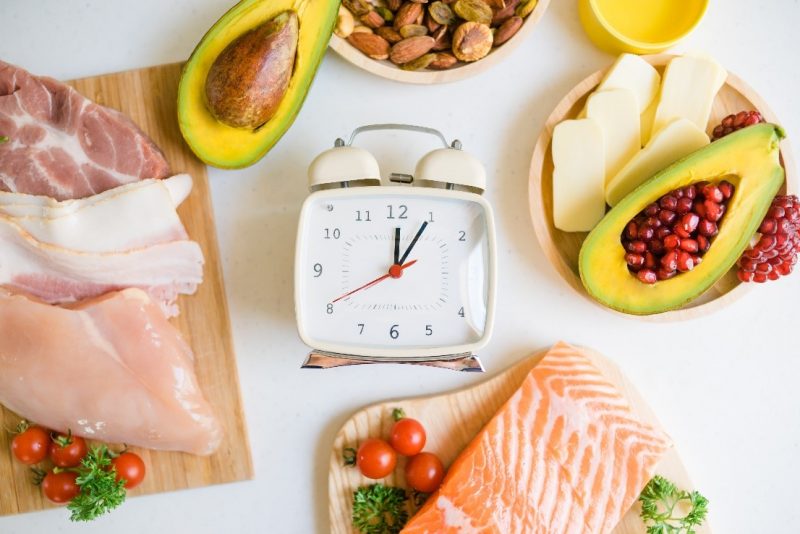Fasting, both prolonged and intermittent fasting, has gained great popularity in the last decade for its numerous health benefits. However, while it’s a great tool for weight loss, the health benefits of fasting extend beyond weight loss.
Several studies show that fasting can help prevent non-communicable diseases such as cancer, hypertension, and diabetes. In fact, there are studies that show that it can reverse type 2 diabetes and hypertension.
However, you may be wondering how long you need to fast and how frequently you have to fast to get these benefits?
When fasting, your body goes through 5 main stages. In each stage, specific physiological and biochemical processes take place. Also, the body switches its main sources of energy and type and level of hormones. As such, there are specific health benefits associated with the various stages.
This article will discuss the 5 stages of fasting as outlined by Dr. George Cahill in his article “Fuel Metabolism in Starvation.”
Table of Contents
The 5 Stages of Fasting
George categorized the 5 stages according to the type of energy the body uses at a given time. The body mainly has two main sources of energy: Glucose and triglycerides.
Glucose is derived from carbohydrates and sugar, while triglycerides are stored in the form of body fat. Excess blood glucose is stored in the liver and skeletal muscles in the form of glycogen.
Most body cells and organs except the brain can use either form of energy fuel. However, the brain predominantly operates on glucose.
Primarily, the body utilizes the available blood glucose for energy. However, if there is no readily available glucose, it breaks down stored glycogen into glucose and releases it into the bloodstream. If glycogen reserves have been depleted, it draws into the body fat reserves for energy.
The fat cells release triglycerides into the liver. They are then broken down into fatty acids and glycerol. Glycerol is converted into glucose for the brain while the fat is burned to produce energy. With prolonged fasting, the body enters the state of ketosis, where it converts stored body fat into ketones for energy.
Stage 1: Fed State (0-4 Hours)
This is the stage immediately after a meal, and this fasting period lasts up to 4 hours. In this phase, a lot of glucose is available in the bloodstream, particularly if your meal contained carbohydrates. In this phase, all the cells and organs in the body use glucose as their primary energy source.
The liver produces high levels of insulin to convert carbohydrates and sugars into glucose. If there is an excess supply of glucose, it converts it into glycogen or triglycerides for storage in the liver, muscles, and fat cells. High insulin production inhibits fat breakdown.
Stage 2: Post-Absorptive Phase (4-16 Hours)
This second phase of fasting lasts 4-16 hours after your last meal. In this fasting period, most of the glucose that was in the bloodstream has been used up or stored. However, most of the organs continue to use glucose from the stored glycogen reserves. As such, insulin levels begin to decline.
If your meal was low in carbohydrates, the stored glycogen levels are relatively low. Therefore, the body will fall back on the stored fat for energy.
Lowers Risk of Chronic Illnesses
Several studies indicated that elevated insulin levels over a long time are a risk factor for chronic illnesses such as obesity, PCOS, cancer, Alzheimer’s disease, Parkinson’s disease, Type 2 Diabetes, and Metabolic syndrome. Also, high insulin levels can cause water retention and bloat.
Increased Levels of Counter Regulatory Hormones
Therefore, the low insulin levels in this stage offer numerous health benefits. Aside from preventing chronic illnesses, low insulin levels trigger the production of counter-regulatory hormones such as adrenalin, cortisol, glucagon, noradrenaline, and human growth hormone.
These hormones mobilize the body to utilize glycogen and fat reserves for energy. Human growth hormone also promotes cell generation and repair while the rest of the hormones increase the basal metabolic rate.
Stage 3: Gluconeogenesis (16-30 Hours)
Depending on your basal metabolic rate, the body will have exhausted its glycogen stores with 16-30 hours of fasting. However, the body is not yet in full ketosis; therefore, it still needs glucose. The liver, through the process of gluconeogenesis, makes glucose using protein.
Some people worry that this stage of fasting may be detrimental to their muscle growth and retention. On the contrary, the liver does not use protein from muscle mass; rather, it uses protein from body tissues that are no longer in use. This intercellular recycling system kicks in autophagy.
Autophagy
Autophagy is a critical maintenance procedure for the cells. It gets rid of defective and degraded proteins and organelles. Consequently, it removes pathogens and prevents atypical protein accumulation associated with PCOS, cancer, and atherosclerosis.
Aside from using the protein to produce glucose, the body also uses the recycled proteins produced to build new cells. As a result, autophagy prevents excess skin due to extreme weight loss and rejuvenates the skin and organs.
Stage 4: Ketosis (2-7 Days)
With prolonged fasting, the body enters ketosis. This stage is easily accessible either by prolonged fasts (at least three days) or eating a low-carbohydrate diet such as a ketogenic diet. Although it may take the body up to 7 days to get into full ketosis, most people get into early ketosis within 24 hours of fasting.
In this stage, the body has completely depleted its glycogen stores, and there is minimal glucose being produced in the liver through glycogenosis. The liver now taps on to the triglycerides from stored body fat and converts them to ketones.
Ketones are a special type of fatty acid that crosses the blood-brain barrier. Although the brain’s preferred source of energy is glucose, it also operates effectively on ketone bodies.
Mental Clarity and Optimal Brain Performance
In this phase, many people report having mental clarity and high energy level. In addition, there is a boost in the brain-derived neurotrophic factor (BDNF), a protein that the brain produces to protect brain cells. It also encourages the development of new brain pathways, improves learning capability, and boosts mood.
Boosts Immunity
Ketones promote an anti-inflammatory response in the body. Ketosis also rejuvenates the immune system as it stimulates stem cell production and the formation of new immune cells. In addition, growth hormone production multiplies up to four times in this phase.
Fat Loss
Since the body is primarily tapping into stored fats to produce ketones, there is accelerated fat loss in this phase. In addition, insulin level stabilizes, and the hunger hormone levels (ghrelin) are also quite low. This further facilitates the body’s fat-burning mode, and it is easier for you to eat at a calorie deficit.
Stage 5: Protein Conservation (More than 7 days)
After seven days of fasting, the body becomes fat adapted. It only relies on stored fat for energy. The brain also predominantly relies on ketones for energy. In this phase, most people report not feeling hungry at all. This is because the hunger hormone levels are still quite low, and the body is now adapted to feeding on stored fat.
Some people are concerned that this stage may cause muscle atrophy. On the contrary, the growth hormones are released in high amounts, protecting the muscle and bone mass from degeneration. The human growth hormone also facilitates muscle growth and repair.
How to Fast Effectively
Below are a few strategies for incorporating fasting into your lifestyle.
Intermittent Fasting
Intermittent fasting involves alternating cycles of eating with cycles of fasting. There are various strategies for intermittent fasting, including:
- Time-Restricted Eating. Eating all your meals for the day within 4-12 hours in a day. Preferably before sunset.
- One Meal a Day. Eating only one meal in a day within 1-2 hours.
- Alternate Day Fasting. Alternating between zero-calorie and calorie restriction days and normal eating days.
- 5:2. Involves eating normally for five days and fasting for two days a week
Prolonged Fasting
A prolonged fasting stage involves going without food for two days and above. Some people fast for even 30 days, while there have been reports on the media of people who fast for more than 100 days. Make sure to consult with your doctor before going on a prolonged fasting period like this.
Conclusion
With a clear understanding of the benefits of fasting and the body’s stages during fasting, it is important that you choose a fasting strategy that works for you. Although you will get the most benefits of fasting by fasting for longer, even fasting for a few hours, 8-12 hours, will improve your health.







